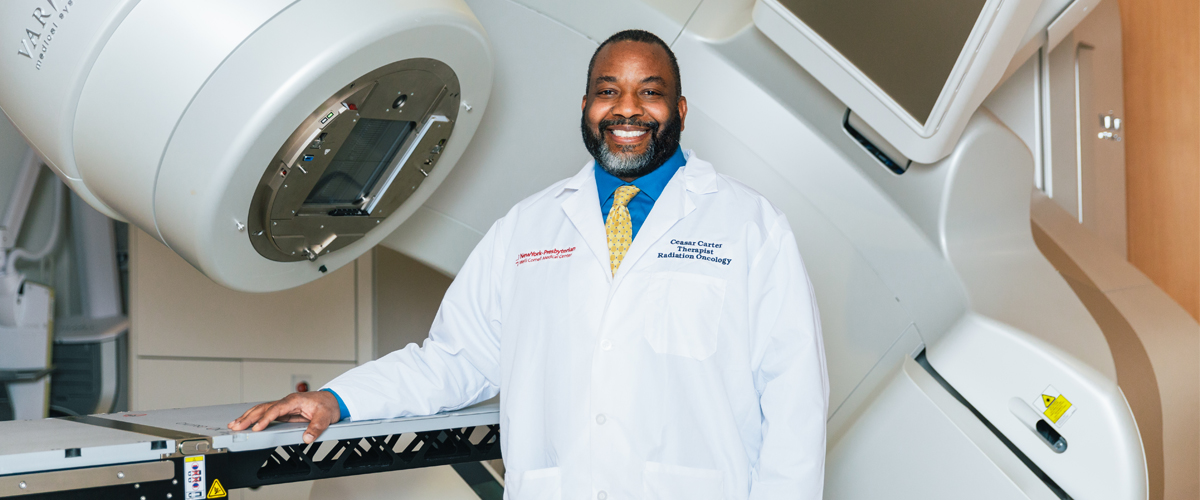Inside NYP: Ceasar Carter
How this senior radiation therapist honors his father by treating patients and their families with great care.

My journey to becoming a radiation therapist began with my father’s diagnosis of esophageal carcinoma when I was in college. He was our family’s breadwinner, but he had to take time off from work to get radiation and chemo treatments. So I put my dreams of becoming an electrical engineer on hold to support the family.
I left City College and landed a job buying and selling used medical equipment. I would call hospitals each day and got very familiar with the equipment used to treat cancer patients — in particular linear accelerators. I worked very long hours, so I couldn’t go with my dad to his treatments. I could only listen to my mother’s accounts of what happened.
I was shocked to hear the stories my mother told me. She said the man I knew, the strongest man in my world, would cry after treatments. She complained about the staff not answering questions. He wanted to be treated like a person and not just a number, like he mattered.
After my father passed away in 1991, I decided to go back to school. At first I was studying nuclear medicine, but then I ran into an old friend who encouraged me to go into radiation therapy. I hesitated at first because of my father’s negative experience, but after speaking to my mother and learning more about the work of radiation therapists, I realized that working as one would allow me to make a difference in the lives of patients like my dad.
Radiation therapists typically see a patient up to 40 times for treatment, for 15 minutes at a time. In those 15 minutes, we have the opportunity to listen to them, comfort them, explain procedures, assess their well-being, and, of course, treat them. My mother told me this was not a part of my father’s experience.
I changed my major to radiology health sciences at Manhattan College and began my training. The job of a radiation therapist is to operate the radiotherapy machine, position patients, and administer doses of radiation designed to control or kill malignant cells. They check the plans for the doctor and the physics calculations to make sure the patient is aligned on the machine and properly positioned to receive the treatment.
I promised myself that if I could become the person who could ease patients’ anxiety and help them get through treatments, then I would be helping my father every day. Knowing how nervous patients can be going into treatment, I’m always happy to hear, “It wasn’t as bad as I thought.”
I think a big issue for patients is feeling like they have no control. So my goal is to try to give them back their control and show them that they are in the driver’s seat, and I am just helping them navigate. I explain the process to them in simple terms and answer any questions they may have. Sometimes I do this by drawing, to show them exactly why the machine may move in certain ways. I tell them to invite family members in to see the machine and so I can answer their questions. If one person has cancer, in a way, the whole family has the illness. If a family member can be happy because their loved one is in good hands, then that is less stress on them, which in turn also benefits the patient.
I’ve been a senior radiation therapist for more than 20 years and have spent the last nine of them here at NewYork-Presbyterian. I was drawn to NewYork-Presbyterian because of its commitment to offering the most innovative, advanced care. This hospital understands patients. NewYork-Presbyterian invests in their people and is committed to having the best available equipment so that patients receive the very best care.
Each day, I treat my patients as I wish my father would have been treated. I connect with them and am proud to let them know I travel from Pennsylvania daily to help them get better. I am able to recharge my batteries when I go home to Pennsylvania. There is a lot of peace and quiet there. I get to spend time in nature and relax. I do woodworking in my free time on the weekends, which involves a lot of math — a lot of angles and aligning things just so, sort of like my job.
All this helps me feel restored, so I can be fully present for my patients. One day a patient asked me, “How many people do you see in a day?” I told her that I don’t know how many I see, because I don’t look at patients as numbers. I try to make them feel like family.
Ceasar B. Carter, LRTT, is a senior radiation therapist at NewYork-Presbyterian/Weill Cornell Medical Center. He works in the radiation therapy center at the NewYork-Presbyterian David H. Koch Center, an ambulatory care center that combines innovative clinical approaches and cutting-edge technology to provide exceptional care and a seamless patient experience.
